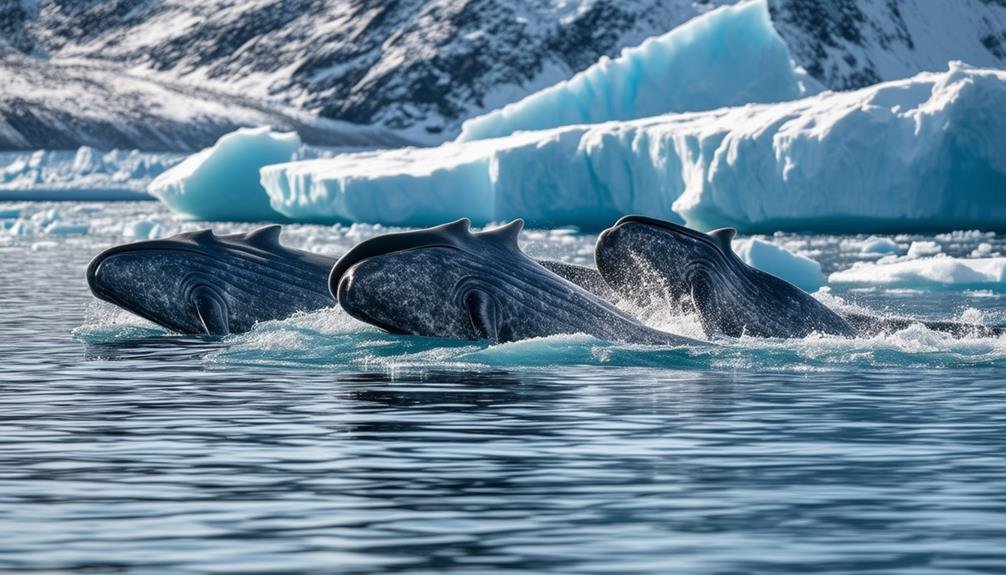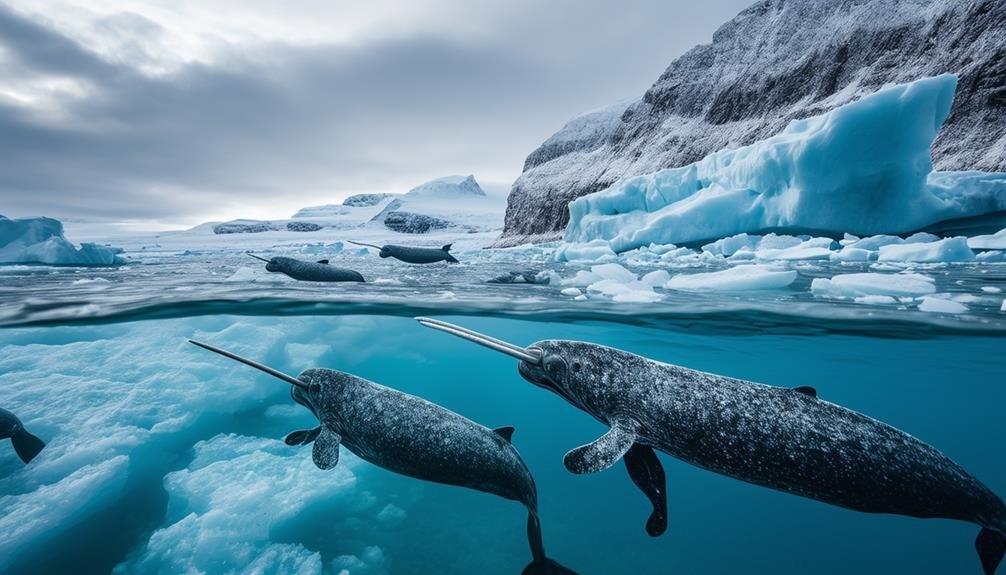The best timeframe for observing wild narwhals is during their spring migration from May to June. During this period, narwhals travel in pods from Davis Strait to the Bylot Island region, often seen at the floe edge. Their visible, coordinated movements make sightings more likely. Summer months present challenges due to their dispersion in feeding grounds, while dense winter ice notably reduces visibility. Notable locations for observing narwhals include the Arctic Canada's floe edge, Isabella Bay, and various coastal areas in Greenland. Broaden your understanding to enhance your viewing experience by exploring more insights into their migratory patterns and habitats.
Main Points
- The best time to observe narwhals is during their spring migration in May and June.
- Summer months provide opportunities to spot narwhals in feeding areas like Admiralty Inlet and Prince Regent Inlet.
- The Arctic Canada's floe edge in spring is an ideal location for narwhal sightings.
- Autumn migration, covering 3,000 kilometers, offers another chance to view narwhals.
- Winter sightings are challenging; focus on ice openings in Baffin Bay-Davis Strait for potential observations.
Spring Migration
Every year, narwhals set out on their spring migration in May and June, making their way from their winter habitats in Davis Strait to the receding ice edges around Baffin Island and Bylot Island. This period is a prime opportunity to witness these elusive marine mammals as they navigate the changing Arctic landscape. During their spring migration, narwhals travel in pods, moving closer to coastlines and exploring the floe edge—where the sea ice meets open water—seeking cracks in the ice to aid their journey.
The tusks of narwhals play an essential sensory function, helping them detect variations in their environment, which is particularly useful as they linger in Lancaster Sound. This narrow waterway between Baffin Island and Devon Island acts as a vital passage during their migration. Tours, such as the Narwhal & Polar Bear Safari, offer rare opportunities for close encounters with these magnificent creatures at the floe edge, making May and June the best months for such experiences.
As the ice melts and the narwhals advance, they provide a unique spectacle for researchers and tourists alike. Observing their behavior during this time offers valuable insights into the species' migratory patterns and adaptation strategies.
Summer Feeding Grounds
As the narwhals complete their spring migration and the Arctic ice continues to recede, they move towards their summer feeding grounds in locations such as Admiralty Inlet and Prince Regent Inlet. During this season, narwhals are primarily focused on feeding, and they dive to depths ranging from 30 to 300 meters in search of their preferred prey, which includes Arctic cod, Greenland halibut, and polar char.
The summer dispersion of narwhals across various feeding grounds can make them harder to locate. Unlike the more concentrated and predictable patterns observed during migration periods, their summer behavior involves roaming further from shore. This increased range in search of food leads to less predictable sightings, as narwhals spread out to exploit different areas rich in their summer diet.
Admiralty Inlet and Prince Regent Inlet are critical habitats during this period, providing abundant feeding opportunities. The narwhals' ability to dive to significant depths allows them to access diverse prey and sustain themselves through the summer months. Observers in these regions may need to employ more advanced tracking techniques to locate these elusive creatures during their dispersed summer foraging activities.
Autumn Migration

During the autumn migration, narwhals undertake an extraordinary journey through Lancaster Sound, covering roughly 3,000 kilometers annually. This migration is indispensable for their survival and reproductive cycles, as it facilitates their adjustment to changing environmental conditions influenced by climate shifts. Observing narwhals during this period offers valuable insights into their behavior and unique adaptations.
Narwhals exhibit distinct behavioral patterns during the autumn migration, adjusting their movements in response to the environmental conditions they encounter. The migration through Lancaster Sound is not only a test of endurance but also a crucial period for the narwhals to prepare for the harsh winter months ahead.
Here are some key aspects to keep in mind when observing narwhals during their autumn migration:
- Behavioral Adaptations: Narwhals display specific behaviors that help them navigate and survive this extensive journey.
- Impact of Climate Shifts: Variations in climate profoundly affect the timing and route of their migration.
- Reproductive Cycles: The migration plays a pivotal role in the reproductive success of narwhals.
- Environmental Conditions: Observing the interaction between narwhals and their changing environment provides essential data for understanding their survival strategies.
Understanding these factors is crucial for researchers and conservationists aiming to protect these magnificent creatures and their habitats.
Winter Habitats
In the frigid expanse of Baffin Bay-Davis Strait, narwhals find refuge under sea ice for up to five months each winter. This winter habitat provides essential protection from predators and harsh weather conditions, ensuring the narwhals' survival during the coldest months of the year. The sea ice cover acts as a shield, while also offering access to necessary food sources.
Narwhals navigate through ice openings, which are crucial for reaching the surface to breathe. These ice openings, known as leads or polynyas, are scattered throughout the Baffin Bay-Davis Strait, allowing narwhals to maintain their respiratory needs despite the extensive ice cover. However, the dense sea ice makes narwhals less visible to observers during winter, complicating efforts to study and view these elusive creatures.
For researchers and enthusiasts, understanding the winter habitats and behaviors of narwhals is vital for optimizing viewing opportunities. Despite the challenges posed by the thick sea ice, strategic observation methods and knowledge of ice openings can enhance the chances of successful sightings. Hence, a thorough understanding of narwhals' winter habits is necessary for anyone aiming to observe these enigmatic marine mammals in their natural environment.
Best Viewing Locations

To observe wild narwhals in their natural habitat, the floe edge of Arctic Canada is renowned as one of the premier locations. This region offers unparalleled opportunities to see these magnificent creatures as they migrate closer to shore during early summer, particularly in May and June. The floe edge not only provides a safe and secure vantage point but also an unforgettable experience for wildlife enthusiasts.
In addition to Arctic Canada, other notable locations for observing narwhals include:
- Isabella Bay: Situated in the eastern Arctic, this bay is known for its rich marine life, including narwhals and polar bears.
- Northwest Passage: This historic route offers stunning vistas and numerous opportunities to see narwhals in their natural environment.
- Greenland: Coastal areas in Greenland also provide excellent viewing spots, particularly during the summer months.
- Arctic Kingdom Safaris: For tailored experiences, Arctic Kingdom offers bespoke tours designed to maximize narwhal sightings.
The best time to see narwhals is early summer when they migrate closer to shore, making Arctic Canada and Greenland prime destinations. For those seeking a detailed and immersive experience, contacting specialized tour providers such as Arctic Kingdom is highly recommended.
Conclusion
Observing wild narwhals efficiently requires understanding their seasonal migrations and habitats. Spring migration offers unique opportunities as narwhals move towards summer feeding grounds. During summer, they are most accessible in Arctic waters. Autumn migration provides another chance to observe them as they travel to winter habitats. Winter sightings are challenging due to harsh conditions but are possible in specific regions. Identifying key viewing locations throughout these periods enhances the likelihood of successful observations.


